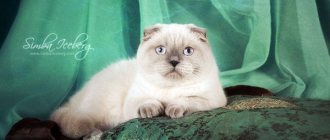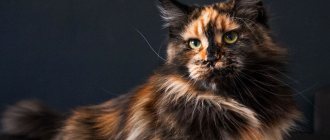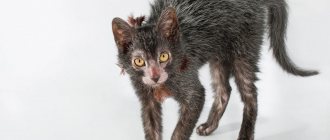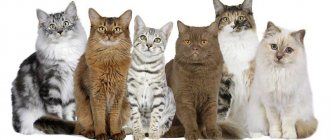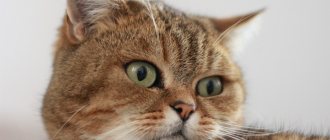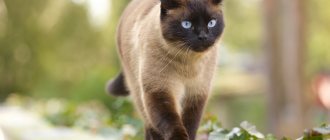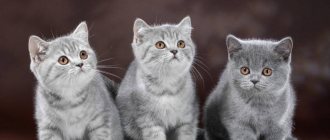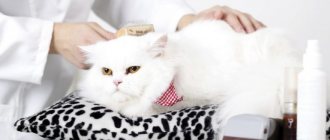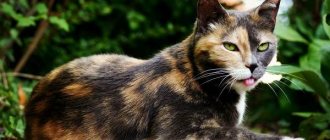If you ask the average person what color Scottish cats are, he will certainly answer that they are gray (the color among professionals is called blue). This is a common color of Scottish cats. But today the variety of colors is very large. Therefore, when asked what colors of Scottish cats there are, you must boldly answer: any! To get such a wide palette, Scots had to be crossed with other breeds. Today, interbreeding is not encouraged, because cats already have the necessary set of genes.
In this article we will answer the following questions: what color are Scottish kittens, what color are Scottish cats, what are the main genes that form the colors of Scottish Fold and Straight-eared cats (Scottish Straight, Scottish Fold, Highland Straight and Highland Fold). Also in the article we will talk about how the color of Scottish kittens changes with age, and show photos of Scottish cats and kittens of almost all colors. Absolutely all colors cannot be presented within the framework of the publication, because... there are a lot of them, and the genes, combining in a bizarre way, still surprise breeders.
Article continues after advertisement
Plain (solid, solid)
The monochrome uniform coloring of Scottish cats is considered classic by breeders. The solid or solid color of the animal implies the absolute exclusion of any inclusions, small marks and specks of a different color. The tone is rich, even along the entire length of the coat.
The most common used to be considered blue plain Scots. But today among the representatives of the breed there are many other variants of solid colors.
White
A Scottish cat with snow-white fur (without yellowness) looks luxurious. Possible eye colors are blue, amber, copper. According to the standard, eyes of different colors are allowed. The paw pads and nose are light pink.
Kittens may have markings of a different shade, which disappear after the first coat change. By the age of two, the coat of a white Scot should be crystal clear, without spots of a different color.
Black
The black cat has expressive yellow eyes. The nose and paw pads practically blend into the main color of the animal.
On the shiny bright coat of the Scottish beauty Ebony, 2-3 hairs of contrasting white color are allowed. The presence of large red or brown marks is not provided for by the standard.
Important: Scottish Fold pets are endowed with magical abilities. It is believed that it is the black color of the Scottish Fold that protects the house and its inhabitants from evil spirits.
Chocolate
The brown Scottish cat, also called chocolate, looks noble and impressive. The color of the coat contrasts with the animal's yellow, golden or copper eyes. The nose and paw pads are also dark brown.
Lilac (lavender)
The monochromatic lilac Scottish Fold has a gentle gray tint that smoothly turns into cream. The nose is slightly brownish, the paws on the bottom are the same color as the coat, in harmony with the main color of the pet. This lilac-lavender color goes well with eyes of copper, amber or orange shades.
Red (red)
Red or ginger color is a rare and valuable color of the Scots breed. The fiery edge is combined with burning amber irises. Pads and nose to match the dominant color.
The tail of kittens and adult animals is not very evenly colored. This deficiency does not disappear with age and is allowed by the standard. And the presence of marks on the head and limbs that remain after reaching the age of two are considered a deviation from the norm.
A red Scottish straight-eared cat can give birth to kittens not only with erect ears, but also with ears pressed to the head.
Cream
The cream or peach fold cat is infinitely elegant and beautiful. The delicate background of light fur, bright golden eyes and a pinkish nose give the pet an irresistible appearance. The pads on the paws are also pink. An animal with this color is similar to a red Scotsman, but its coat color is a shade lighter.
A peach fold kitten may have a blurry, fuzzy pattern on its paws and tail that does not disappear with age. This is not critical for a purebred pet, but leopard markings are absolutely unacceptable.
Faun (deer)
There is another unique color of Scottish fold cats with an interesting name - fawn, which means “young deer”. The nose and pads on the paws of these beauties are beige-pink.
Cinnamon
Cinnamon is a lighter and more delicate color than chocolate, but darker than red. The nose and paw pads of such animals are brown, beige or pink.
Blue color (blue)
The gray or blue Scottish cat has very beautiful amber eyes. The coat tone of a purebred pet can belong to any range of gray - from the lightest (blue) to completely dark (blue). At the same time, each hair is saturated and well colored, without streaks.
The nose and pads practically do not differ in color from the plain coat.
A gray Scottish Straight cat may be marked with a few streaks and drawings in childhood. But as they grow older, these color flaws go away.
A little about genetics
It is especially interesting how the color of a Scottish kitten is formed and what it depends on. In the genome of this breed, two colors predominate, responsible for the color of the animal - red and black. Anyone can, under certain conditions beyond a person’s control, become dominant. Such a gene suppresses weak ones, which are called recessive. There is also a third gene, the so-called diluent. It is responsible for the degree of pigmentation saturation.
When these genes are combined with each other, the most unusual coat colors of an animal can appear. It is extremely difficult to determine in the first weeks what color a kitten will have in the future. The shade he was born with is not constant and may change as he grows older. In some cases, dramatic changes occur. The change in shade begins at six months and lasts up to two years. The table below shows options for crossing the colors of parents, according to which their offspring inherits the coat color.
How the coat colors of the offspring are crossed.
Material on the topic: how to get a Scottish fold cat.
Two-color
A unique coat color is bicolor (two-color cats). The main background is snow-white. The second color in color (cream, black, blue, red) is presented in the form of unusual patterns. Thoroughbred representatives must have white belly, neck, chest, paws, muzzle and beard.
A prerequisite is the predominance of a white background in color. Bicolors are more valued; their body patterns are symmetrical. The eyes can be any shade, but are usually blue or golden yellow.
Cream bicolor
Cute white cats with additional streaks of delicate cream tones. The eyes are blue or yellow, and the nose and pads are pink.
Blue bicolor
The pattern on the wool is blue (delicate or rich gray). The iris of the eyes is a beautiful sky tone or yellow-orange. The nose and paws below are pink.
Black bicolor
Black and white bicolor is characterized by patterns of rich black tone. These cats have a pink nose and blue or copper eyes. A symmetrical, distinct pattern on the skin turns the cat into a real gentleman in a tailcoat.
Color point
Color-point is translated from English as “colored point”. The point coloring is explained by the presence of a gene, under the influence of which the coloring of hairs intensifies in some areas of the body with insufficient blood circulation. Characteristic darkening appears on the main white or cream background of the coat.
The second name of the color is Point Links. The eye color of cats of this color is necessarily blue. Previously, this coat color was observed only in the Siamese breed. But today it is present in other cat species, including Scots.
Newborn kittens are completely white. Only by the age of one month do babies begin to show color on their ears, paws, tail and face. According to this color, several subspecies are distinguished among the points.
Blue Point
This color is characterized by a pale gray-blue, almost white shade of the body with darker, gray markings. Soft gray Scottish blue point kittens have paws and noses that match the main color.
Cream point
The body is creamy white, and the shading on the animal’s face and tail are pastel cream colors. Paw pads and nose are pink. This point color goes harmoniously with the expressive blue eyes of the cat.
Lilac Point
The dominant tone is soft white or lilac, and the markings are gray with a pink tint. The nose and paws are the same as the main color.
Seal Point
The darkest color among the points. The dominant tone is beige. Contrasting with it are brown and black markings. The same dark nose button and paw pads.
Chalklit Point
Chocolate or choclit point is distinguished by a brown pattern on a cream background. Paw pads and nose range from light cocoa to darker brown.
Red point
The main coat color is pale apricot, almost white. Darkening on certain parts of the body is red-red in color. The pads and tip of the nose are bright pink.
Bicolors
The coat color of these beautiful creatures has two colors, and a combination of white and any other shade is mandatory. Purebred bicolors must have a white belly, neck, chest, chin, limbs and, of course, muzzle.
Particolor (calico)
A Scottish cat of this type, called particolor, is a combination of white with tortoiseshell or spotted tabby color.
Harlequin
Harlequin captivated everyone with his unusual appearance. The cat is painted white (4/5 parts of the body), but the tail must be black, as well as the ears and the top of the head. The ventral part is white. The tip of the nose, like most people, is the same color – pink.
Wang
This breed only has colored tail, and sometimes has a few spots on the head. It happens that there are solid spots on the paws and back, but this is considered undesirable. When this breed develops red spots, it may also be called a Red Van.
Tortoiseshells (torties)
The tortoiseshell color of Scottish Folds is usually tri-colored. Red, white, and black spots are located on a cream or red dominant background. When the genes of the parents are combined in a tortoiseshell kitten, these markings can take on chocolate, blue and cream shades.
When assessing tortoiseshell cats, felinologists pay attention to the even distribution of markings and the intensity of their tone. Fold-eared and straight-eared Scots with a tortoiseshell color are divided into subspecies (depending on the color scheme of the spots).
Black-red
There are black and red-red patterns all over the cat's body. The sizes and shapes of the spots are very diverse. This color is often called tortie.
Chocolate red
The patterns on the wool are brown and red. They stand out against a lighter background and look very interesting. The chocolate red color is considered rare and prized by breeders.
Blue-cream
The tortoiseshell blue-cream color in Scottish pets is determined when the main gray-blue background is covered here and there with small light cream spots.
Important: tortoiseshell coloring is characteristic only of cats. The calico cat is very rare. The appearance of a male tortoiseshell kitten indicates genetic problems. Most likely, an adult pet will not be able to have offspring, since the reproductive functions of its body are impaired.
Rare colors of Scottish cats
Many readers ask what the rarest and most expensive colors of Scottish cats are. Today there are no problems finding any color, however, among breeders trying to get the maximum variety of colors of kittens from one cat, tortoiseshell cats are very much appreciated, because... they carry the genes of both the red and black series at once. Among ordinary people who are not involved in breeding, the so-called precious colors - gold and silver - are now in fashion. However, these colors can no longer be called rare, since such cats are becoming more and more popular due to their popularity.
And for those who are in search of what is the best color of Scottish cats, let’s say: this is the color that you like, because you live with this cat. You may become interested in cats whose color is as close to natural as possible, that is, spotted or tabby. Or maybe you will like red (ginger) cats, because... they please the eye and improve your mood with their appearance. Whatever color you choose, the main thing is that you like it.
Smoky (smoky, tuxedo)
The color of Scottish Fold cats can be smoky. On top the coat is one color, for example black. And at the base, each hair is silvery-white. This coloring is characteristic of cats with a dominant silver gene, which creates unusual combinations of light and dark shades.
Smoky color is easy to confuse with solid color. To avoid mistakes, you just need to look at the undercoat. With a smoky color, the undercoat of a different shade is clearly visible, and with a solid color, the color of the roots does not differ from the tips.
The eyes of smoke cats are usually yellow-gold in color. Based on the shades of smoke on the fur, several subspecies of this color of animal are distinguished.
Blue smoke
Smoky blue Scottish Straights and Scottish Folds are distinguished by the color of their fur coat with a gray cold coating. But underneath the fur is white and silvery. The paw pads and nose of these pets are gray-blue.
Black smoke
This color in Scottish cats is characterized by a black edge, but the hair at the roots is white. The nose mirror and pads do not differ from the main background.
Chocolate smoke
The snow-white undercoat is combined with a brown-chocolate topcoat. The nose button and paw pads of these animals are brown in color.
Smoky Scottish Straights and Scottish Folds, despite their unique color, cannot participate in exhibitions. Such cats are not recognized by the breed standard.
Scottish cat colors and types
The colors of Scottish cats are divided into solid, tortoiseshell, smoke, tabby, bicolor, van, harlequin, shaded, chinchilla, point and ticked. This does not depend on the type of breed. Such colors can equally be found in Scottish folds, Scottish straights, highland folds and highland straights.
Solid (solid, monochromatic) colors
Solid color means that there are no inclusions of another color. The tone should be rich and even along the entire length of the hairs. If there are inclusions of a different color, this is either a different color or a defect, which reduces the price of the kitten and lowers the ratings at shows. Solid colors come in blue (what lay people call grey), black (ebony), white, brown (chocolate), lilac, fawn (meaning “young fawn” in English), cinnamon (cinnamon), red and cream. Until recently, blue was considered a classic: such cats were the majority. However, today this is no longer the case. However, black, white, chocolate and red Scots are rarer creatures.
- Red
- White
- Lilac
- Blue
- Cream
- Black
- Cinnamon
- Chocolate
- Faun
Two-color (bicolor)
Bicolor is the color of Scottish cats in which half the surface of the coat is white, and the other half is blue, cream, red or tabby. It is desirable that the drawings are symmetrical.
- Lilac bicolor
- Blue bicolor
- Black bicolor
Point colors
The body of color point cats should have a basic light tone, and the face, ears, paws and tail should be darker. Hence the name: translated from English, the word “color” means “color”, and “point” means “point”.
Scottish point cats can be of several varieties: seal point, lilac point (white body with lilac markings), blue point (light body and light blue markings), chokelit point (white body and brown markings), cream point (light cream body and cream markings), tortoiseshell (tortoiseshell, which combines the base color markings with red or cream spots), tabby point (striped markings).
There are other options for points. Point-colored cats are produced using an interesting gene that causes the fur to darken depending on the temperature. In those parts of the body where the temperature is lower due to poorer blood circulation (paws, muzzle, ears and tail), the color is darker.
- Blue Point
- Red point
- Torty point
- Smoky Point
- Chalklit Point
- Links Point
- Lilac Point
- Golden Point
- Point with darkened body
Tortoiseshells (torties)
In order for a cat to be called a tortoiseshell, it must have a combination of dark spots and red or cream spots on its fur. The distribution of these colors throughout the body is even. But do not confuse tortoiseshell kittens with tricolor ones. Tortoiseshell colors can be black-red, chocolate-red, blue-cream, lilac-cream. At exhibitions, first of all, they look at the uniformity and harmonious distribution of pigments, as well as intensity. It is worth considering that only cats can be tortoiseshell. If it appears in a cat, it is a genetic mutation indicating the inability to produce offspring.
Smoky (smoky, smoky) colors
With this color, the cat should have a uniform tone and the base of the hairs should be silver-white. That is, part of the length of the hair can be, for example, black, and the base can be silver-white. This unusual coloring of each hair is called typing.
Article continues after advertisement
The smoky color belongs to the silver group and appears under the influence of the dominant silver gene. With a smoky color there should be no pattern on the coat, although it occurs in some individuals. This color can be confused with a solid color, because usually the hair is colored two-thirds of the way, and if the coat is thick, you need to move the hairs apart to see the base.
Tabby colors
Tabby cats have a zonal pattern. For example, this could be the letter M on the forehead, light spots on the back of the ear, lining the eyes and nose, curls on the cheeks, a necklace on the chest, rings on the legs and tail.
Tabby cats are divided into:
- depending on the type of pattern - brindle (mackerel), spotted (spotted) and marbled color (shaded);
- depending on color combinations - silver (silver shade main and black pattern), silver-blue (white undercoat and mantle on the sides, muzzle and tail), red (light red main and bright red pattern), brown ( copper color and black pattern), blue (cream blue base and bright blue pattern), cream (pale cream base and dark cream or beige pattern), cameo tabby (white color with a bright red stripe pattern).
Particolor (calico)
Particolor cats have a combination of tortoiseshell and white on their fur.
Chinchilla
There is such an effect as tipping. The word “tipping” means an uneven distribution of pigment along the length of the coat, in which only the tip of the hair is colored, and the rest remains white. Tipping is typical for chinchilla, shaded and patterned colors. There are different types of tipping, depending on which part of the hair is dyed, that is, what is the length of the dyed part.
With chinchilla coloring, one eighth of the hair length is colored, the rest is white. Cats of this color are divided into the following subspecies: silver chinchilla, golden chinchilla, blue golden chinchilla. The latter is the rarest among chinchillas. These are very beautiful cats. Hence the high prices.
Ticked colors
The word “ticking” means uneven coloring of the hair, but not in two different colors, as with tipping, but in three. Ticking is a uniform zonal coloring with alternating dark yellow rings along the entire length of the hair and a dark top without traces of a pattern. Stripes of different colors alternate across each hair, creating unique shades. Those who do not know about this effect try to describe a ticked cat with approximately the following words: “its fur shimmers in different colors,” “its fur has several colors and shades,” etc. Among Scottish cats, this color is not yet the most common; ticked cats are expensive.
Shaded (shedded) colors
Shaded colors are colors in which only the upper third of the tip of the hair is colored, the rest is white. Carriers of this color have a light undercoat, shaded hair on the sides, back, ears, head and tail, light hair on the chin, belly and bottom of the tail, coloring only the upper part of the hair in any of the main color colors (gold, silver, red). Shaded colors are divided into shaded golden, shaded silver, shaded red. There should be no noticeable pattern, but an M on the forehead and dark rings on the paws are acceptable.
Article continues after advertisement
Wang
Scottish Van cats have a white body except for the tail and muzzle. A few spots on the body and legs are also allowed. The coat on the spots may not be plain, but, for example, tabby.
Harlequin
Harlequins are off-white on about one-fifth or one-sixth of the body, and the spots may be scattered in different places rather than concentrated near each other. The tail is colored. The rest of the body is white. Outwardly, such cats really resemble harlequins, hence the name.
Tabby colors
Scottish tabby cats are very popular among breed lovers. This color suggests the presence of patterns on the pet’s fur.
Depending on their shape and size, tabbies are divided into three types:
- Striped (tiger) color - the presence of clearly defined vertical stripes.
- Spotted (leopard) - the pattern is made up of spots on the animal's fur.
- Marble color is a pattern of larger chaotic marks of different shapes.
A prerequisite for tabby cats is the presence of the letter “M” on the top of the animal’s forehead. The color combinations of wool are surprising in their diversity:
- cream;
- golden;
- blue;
- marble on silver;
- black marble;
- silver;
- silver-blue.
Important: Scottish tabbies with a silver tabby color resemble the mustachioed pet from a cat food commercial. Many believe that it is the Scottish straight-eared cat with a tabby pattern that appears on the screen. This color is also called the whiskey color of Scottish cats.
Color codes
Cat identification is supported by both WCF (World Cat Federation) and FIFe (Federation Internationale Feline). It is not so difficult to understand it, and in the future there will be no problems determining the breed and characteristics of the animal you like.
The breed code looks like this: ХХХ.хх.NN.NN.NN.(NN). The decoding of this “formula” is as follows: XXX – large English letters of the name of the breed, example:
- SFL – Scottishfold.
- SFS – Scottish Strike.
- BRI - British.
- MAN – cat o. Maine, and further down the list.
Next come two lowercase English letters - xx. The first one represents the base color. Example:
- n – black color.
- w – white color.
- g – blue-cream turtle, and so on.
There are only two second letters: s – silver and y – golden. Example: ns – black silver (smoky), ny – black gold. Other pairs of numbers, when needed, now the last pair is not used. Number one indicates the type of feature, the second – the feature itself, it looks like this:
- if the number is 0 – the presence of a white color scheme.
- 1 – degree of tipping for silver colors.
- 2 – indicates the type of pattern in tiger colors.
- 3 – determines the type of point color.
- 5 – determines the length of the tail.
- 6 – eye coloring.
- 7 – ear placement.
Now examples:
03 – two-tone bicolor. 11, shaded, ¼ of the end part of the hair is darkened. 23 – tabby color. 34 – Singapore color. 51 – taillessness. 63 – disagreement. 73 – fold. 71 – straight and so on.
Now let's look at a few examples:
SFSns2271 – black and silver marbled Scottish strike. Here 22 are marbled, 71 are straight ears. Next: BRIw63 is a white British man with different eyes. MANg226251 – cat o. Maine, blue-cream turtle, tailless, eyes, orange. Here 51 are tailless, 62 are orange eyes.
Chinchilla
The Scottish chinchilla borrowed the extravagant colors of its coat from the British, and they, in turn, from Persian cats. A chinchilla kitten is born only from parents with an unusual color. Each hair is colored in two colors.
Most of it is light in color and 1/8 of it (the top) is dark in color. This phenomenon is called tipping.
Tipped chinchilla colors can be of 3 types:
- Golden. The cat has a white undercoat. But on top there is a reddish coating over almost the entire surface of the body (on the sides, back and tail of the animal). Only the beard, the tips of the ears and the belly are white. Yellow-gold eyes, pink pads and a brick-colored nose.
- Silver. White wool coated with silver gives an interesting gray effect. The color of the tail has a hint of stripes, the nose is beige, and the eyes are green. Snow-white tips of the pet's ears, chin and belly.
- Blue golden. The rarest and therefore valuable color of Scottish chinchillas. The undercoat is a delicate caramel color, and the tips of the hair are a radiant blue hue. The eyes are natural emeralds of a rich green tone.
Shaded (shedded) colors
An unusual definition refers to the interesting color of Scottish cats - shaded colors. These pets have almost white fur, but the tip of the guard hair is colored.
The top layer of a cat's coat can be any shade typical of Scottish cats. The undercoat is white. The sides, back, head, tail and ears are shaded. Light belly, chin and lower tail. There should be no obvious spots. The “M” sign on the forehead and darkish rings on the paws are acceptable.
Shedded colors can be of three varieties:
- Golden. The fur of the Scottish cat is golden, the undercoat is cream or light peach. Green eyes are very expressive and beautiful. The nose button and paw pads are chocolate.
- Red. This type of shaded color has a dark red coating on the coat with a snow-white undercoat. The eyes are amber, the pads and nose are pink.
- Silver. The white undercoat combined with the dark gray topcoat produces an amazing gray tint. Greenish eyes are lined with black stripes. This feature is typical only for the silver shedded color. Other varieties have eyes without a contour. The nose is brick-colored and the mouth is dark-lined.
Matching eye color to coat color
Until four months it is impossible to determine eye color. It can be identified by its fur, the shade of which may change. There is a special table by which you can determine the eyes of an animal. It must be remembered that the final result cannot be guaranteed, but in the vast majority of cases it coincides with the data in the table.
Table of correspondence between eye color and coat color of Scottish cats.
